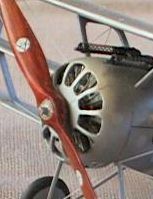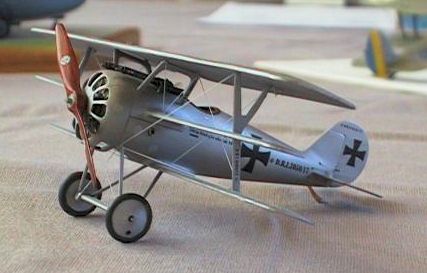The esoteric Pfalz Dr. I
text and photos by Martin Waligorski
model by Anders Bruun
The very first Pfalz aircraft built were license-production Morane-Saulnier planes, the Type L parasol and the Type H, which became the Pfalz E series. These early Pfalz productions soon proved to be of inadequate performance, and Pfalz opted for license production of Roland fighters to gain further experience. Thanks to the important technological advances gained, Pfalz proved later to be fully capable of designing and producing their own succesful aircraft. Fighter types like the D.III and the D.XII are well-known, but there were also a lot of prototypes, both biplane and triplane.
Following the huge initial success of the Fokker Dr. I triplane fighter, German manufacturers created many intended replacement triplane fighters. In this rush for more triplane designs Pfalz was no exception. As it happened, most of the efforts proved abortive. The only type that came close to matching the success of the Fokker was the Pfalz Dr.I.
The Dr. I was in itself derived from the biplane Pfalz D.VII (of which only one prototype was built). The characteristic feature was a very narrow chord of the middle wing. This was intended to aid visibility from the cockpit. The wooden monocoque fuselage bore strong resemblance to the D.III. The aircraft was powered by the Siemens und Halske Sh III rotary engine driving a huge propeller which in turn required a very long undercarriage.
Although Pfalz Dr. I reached series production,  it ended with only 10-15 machines. These aircraft were intended for service trials, but the reports were unfavourable. It is unconclusive whether the aircraft had ever seen combat use.
it ended with only 10-15 machines. These aircraft were intended for service trials, but the reports were unfavourable. It is unconclusive whether the aircraft had ever seen combat use.
By mid-1918, the triplane fighter craze was all but over. The next series-produced fighter from Pfalz was the excellent D.XII biplane – but as they say, that’s an entirely different story…
The model
Anders Bruun’s award-winning 1/72 model depicts Pfalz Dr. I no. 3050/17. This particular aircraft had the distinction of being flown by the ”Red Baron” Manfred von Richthofen himself, albeit on only one occasion – during his visit at Pfalz factory in December 1917. Reportedly the ace was very impressed with qualities of the type. For example, the Pfalz triplane could easily outclimb its Fokker counterpart.
The model was built from Merlin limited-run kit. Merlin kits are fairly typical cottage industry products. ”Frankly, the moulds were of quite crude quality” – says Anders – ”The model required a lot of corrections, replacements and additions”. Most of the replacement parts were scratch built. The two machine guns are photoetched items coming from Eduard.
Production Dr. Is featured a factory silver-dope finish, making it for a relatively easy paint job. Besides the usual details like tyres, guns and the cockpit rim, Anders hand-painted the prominent wooden propeller.
The model was completed with home-printed decals. The designs were drawn on the computer using Corel Draw software, then printed on clear decal film using an ALPS MD-1000 printer.
This article was originally published in IPMS Stockholm Magazine in July 2001.

